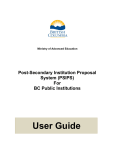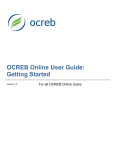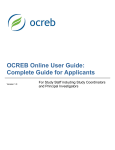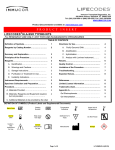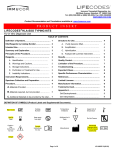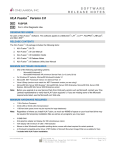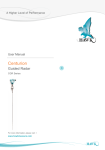Download User Guide - Ministry of Advanced Education
Transcript
Ministry of Advanced Education Post-Secondary Institution Proposal System (PSIPS) For Private and Out-of-Province Public Institutions User Guide Contents Document Purpose ..................................................................................................................... 1 Overview ...................................................................................................................................... 1 Degree Quality Assessment Board (DQAB) Process .................................................. 1 The System in a Nutshell ............................................................................................. 1 About Documents and Comments ............................................................................... 1 Why do we use Adobe Acrobat PDF files? .................................................................. 2 Where can I get help? ................................................................................................. 2 Application States ........................................................................................................ 2 System Basics............................................................................................................................. 8 Minimum Requirements ............................................................................................... 8 Browser Navigation Buttons ........................................................................................ 8 Applicant Actions – Private and Out-of-Province Public Institutions ............................ 8 Screen Reference........................................................................................................................ 9 Visual Reference Guide ............................................................................................................ 10 How do I log in? ......................................................................................................... 10 How do I update contact information? ....................................................................... 11 How do I modify my password? ................................................................................. 12 How do I re-assign an Institutional Contact? ............................................................. 14 How do I confirm organization information and attach an organization profile? ......... 15 How do I upload Institution Appendices? ................................................................... 16 How do I submit a proposal? ..................................................................................... 18 How do I submit a Qualified for Expedited Review proposal? ................................... 25 How do I view proposal information? ......................................................................... 30 How do I replace a document if revisions are required? ............................................ 32 How do I set my proposal as active program? ........................................................... 34 How do I provide response to proposal with “Expert Review Completion Confirmed” status? ....................................................................................................................... 36 How do I submit an Organization Review? ................................................................ 37 How do I withdraw a proposal? .................................................................................. 37 How do I put a proposal on hold? .............................................................................. 37 How do I view my invoice? ........................................................................................ 37 How do I report the implementation status of an approved proposal? ....................... 39 How do I search for other institutions’ proposal? ....................................................... 42 How do I upload an Annual Report and its Appendices? ........................................... 43 How do I view my Annual Reports? ........................................................................... 47 How do I view Periodic Review Report? .................................................................... 48 When will my proposal expire? .................................................................................. 49 Error Messages ......................................................................................................................... 50 Log-in Errors .............................................................................................................. 50 Timeout Errors ........................................................................................................... 50 Field Errors ................................................................................................................ 51 PSIPS Quick Reference Guide (Private and Out-of-Province Public Institutions) .............. 55 BC Private and Out-of-Province Public Institutions: PSIPS User Guide Document Purpose The Post-Secondary Institution Proposal System (PSIPS) is a web-based system for supporting the post-secondary program proposal and quality assessment review processes for degree-granting institutions in British Columbia. The purpose of this guide is to document the functions of PSIPS for private and out-of-province public post-secondary institutions proposal submission. Overview Degree Quality Assessment Board (DQAB) Process In British Columbia, private institutions or public institutions from another jurisdiction wishing to operate as degreegranting institutions or make use of the word “university”, must undergo a quality assessment process and meet established criteria prior to the Minister granting consent under the Degree Authorization Act (DAA). The full text of the DAA can be found at: Degree Authorization Act The Degree Quality Assessment Board (DQAB) is appointed by the Minister to conduct quality assessment reviews and make recommendations on whether institutions and proposals meet the established criteria. The Board Secretariat within the Ministry provides administrative support to the DQAB, the quality assessment process and applicant institutions. The quality assessment process is initiated with a 30-day public review of the proposal. The proposal is posted on the Degree Authorization website via PSIPS, enabling the general public (including academic experts from inside and outside British Columbia) the opportunity to review the proposal and provide comments to the applicant institution and the Board for consideration in the review process. The Board’s recommendation and the Minister’s decision to grant or deny consent are also posted on the Degree Authorization website via PSIPS. This is to reflect the Board and the Ministry’s commitment to ensuring the interests of the public are served by having an open and accountable process. Applicants should review the Degree Authorization website that includes complete information on the submission, review and approval processes and the quality assessment criteria established by the Minister prior to submitting a proposal. Institutions are encouraged to submit proposals on PSIPS 12-18 months prior to the planned implementation date of the program to allow enough time for the quality assessment process to be completed. The System in a Nutshell PSIPS is a central online program for institutions to submit proposals for degree programs, use of the word “university” and applications to obtain Qualified for Expedited Review. Key documents and decisions about an institution’s program proposal are stored in a database. Documents and data are entered electronically and Institutional contacts are notified automatically by email at key review points. Comments can be entered directly on an online screen or documents can be attached to a proposal. About Documents and Comments The system is designed to be somewhat like a message board and does not limit the number of comments or documents that can be posted regarding a proposal. Unlike an informal message board, all postings become part of the government record. Institutions are encouraged to post only official communications (i.e., no draft documents or unofficial responses). If the applicant institution wishes to clarify a posted statement, an additional comment or document must be posted. Detailed discussions or questions about the proposal should be conducted offline with the Board Secretariat via phone or e-mail. The results of these discussions may then be posted as a single comment. Following this guideline will create a clear record of specific issues, responses and positions related to the proposal. The PSIPS system allows for online comments to be recorded (up to 4500 characters). If a more detailed comment is required, a PDF document may be attached. –1– BC Private and Out-of-Province Public Institutions: PSIPS User Guide Why do we use Adobe Acrobat PDF files? We want everyone to be able to view attachments regardless of what type of computer, word processor or toolset was used to create a document. If your institution does not have Adobe Acrobat software, Adobe offers a free reader and an affordable online subscription service to convert your documents at www.adobe.com. If you have specific questions on the creation of PDF documents, please refer to Adobe Acrobat documentation. Some of the documents like Institution reports and their appendices can be in any format. Where can I get help? In addition to this manual, the following help is available: • • Ministry web site outlining application and review steps Degree Authorization website The Degree Quality Assessment Board Secretariat at 250-356-5406 (Monday to Friday 8:30 am to 4:30 pm) Application States An application will be in one of several states depending on the type of application (or proposals), applicant actions, time in review, and Board Secretariat actions. Allowable actions are limited based on user role. For the most part, users will not need to worry about status changes as the system manages status changes automatically, but it is useful to know the stages an application must go through before a Ministerial decision is made. The following diagrams cover three types of applications (proposals): • • • Private and Out-Of-Province Degree proposals Application to use the word “University” Application to be qualified for expedited review The simplified path of applications of the first two types is shown on the Figure 2 Status Transitions – Degree Assessments, and Applications to use the word ‘University’. It displays transition matrix for application’s statuses in case when a Private or Out-Of-Province institution, which has submitted a proposal, does not have an application, which have passed through the Ministerial Consent status. If an institution already has at least one application which has reached the Ministerial Consent state at some point, then the proposal must now undergo the Peer Review process according to the new mandate for Transparency and Equal Access. The peer review process is a 30 day review done by the peer institutions both public and private. The peers will review the proposal and documents and submit comments or upload relevant documents. To participate in the peer review they will need to click on the ‘Find Proposals’ bottom in their home page, review the proposals in Peer Review Status and enter a comment or upload a document. Once 30 days have passed, the proposal can be submitted to the Secretariat for review. The following diagram illustrates the Peer Review flow. –2– BC Private and Out-of-Province Public Institutions: PSIPS User Guide Peer Review Stage Peer Review Revisions Pending (Hold) Initial Entry (Open) Ready for Peer Review (Open) Peer Review Requested (Open) Revisions Required (Open) Peer Review Withdrawn (Closed) Peer Review (Open) End of Peer Review (Open) Submitted to Secretariat (Open) Figure 1 Peer Review flow. In this case, i.e. when a Private or Out-Of-Province institution already has at least one application which has reached the Ministerial Consent state at some point, members of the VP Academic role, who belong to the institution, have the following additional functionality: • • View, in their home page, all existing proposals, from BC Public and Private and Out-of-Province Public institutions and their proposal documents excluding appendices, which are considered to carry proprietary information and are not visible to peers; Participate in the 30-day peer review process. The latter means that applications for the use of the word University and degree proposals coming from institutions, which have to undergo the Peer Review process according to the new mandate for Transparency and Equal Access, have an additional block shown on the diagram above, which stands between Initial Entry and Submitted to Secretariat blocks. The flow for this case is shown on the Figure 3 Status Transitions – Degree Assessments, and Applications to use the word ‘University’ for the case when an institution has a proposal in the status of Ministerial Consent. The proposal passing the Peer Review phase is posted on the Degree Authorization website via PSIPS, enabling the general public (including academic experts from inside and outside British Columbia) the opportunity to review the proposal and provide comments to the applicant institution and the Board for consideration in the review process. Other BC public institutions can view the proposal via PSIPS and provide peer comments directly within the system to the applicant institution. The Board’s recommendation and the Minister’s decision to approve or deny degree program proposals are also posted on the Degree Authorization website via PSIPS. This is to reflect the Board and the Ministry’s commitment to ensuring the interests of the public are served by having an open and accountable process. –3– BC Private and Out-of-Province Public Institutions: PSIPS User Guide PSIPS – Private and Out of Province Public Institutions Status Transitions – Degree Assessments and Applications to use the word ‘University’ Initial Entry (Open) Submitted to Secretariat (Open) Applicant Verified (Open) Secretariat Applicant When degree application has Qualified for Expedited Review and wasn’t previously assessed as Full Review Required. Revisions Required (Open) Secretariat When FFP attached Only Secretariat may reset Under Review (Open) Expert Review Assigned (Open) set automatically when paid and Verified Exempt Verification (Open) Full Review Required (Open) * Secretariat may place the submission on hold, or withdraw it anytime. Expert Review Completed (Open) (automatic) Degree Quality Assessment Board Recommendation DQAB Recommend Approval (Open) DQAB Recommend Denial (Open) Expert Review Completion Confirmed (Open) Minister Decision *This status should be used to record any postconsent activity, such as amendments to T & C, consent suspensions, and consent revocation. Details can be recorded in the Comment field. On Hold (Hold) Degree Assessments and Applications to use the word ‘University’ T&C Sent (Open) PostApproval Change (Open) Applicant Signed T&C (Open) Due date expired Minister Denied (Closed) Minister Consent (Open) Withdrawn (Closed) Applicant set proposal active status & active date Expert Review Response (Open) *If Hold removed, application returns to last status. Implemented Expired (Closed) Figure 2 Status Transitions – Degree Assessments, and Applications to use the word ‘University’. –4– BC Private and Out-of-Province Public Institutions: PSIPS User Guide Figure 3 Status Transitions – Degree Assessments, and Applications to use the word ‘University’ for the case when an institution has a proposal in the status of Ministerial Consent –5– BC Private and Out-of-Province Public Institutions: PSIPS User Guide The last diagram in this section stands for applications to be qualified for expedited review. This is a new name for the type of applications formerly known as applications for Exempt status. Private and Out-of-Province organization are able to see and apply for Expedited Review once they have one or more proposal which reached or passed the Ministerial Consent state. –6– BC Private and Out-of-Province Public Institutions: PSIPS User Guide PSIPS – Private and Out of Province Public Institutions Status Transitions – Qualified for Expedited Review Peer Review Stage Peer Review Revisions Pending (Hold) Peer Review Withdrawn (Closed) If the Application Withdraws it, the application is closed (permanently). If the Application sets to “Revisions Pending”, can only resume through Requesting a Peer Review. Applicant can revise or Withdraw at any point prior to Submission. Ready for Peer Review (Open) Initial Entry (Open) Peer Review Requested (Open) Peer Review (Open) Revisions Required (Open) End of Peer Review (Open) Withdrawn (Closed) * Secretariat may place the submission on hold, or withdraw it anytime. Degree Quality Assessment Process Submitted to Secretariat (Open) Verified (Open) On Hold (Hold) Under Review (Open) When Paid Expert Review Assigned (Open) Degree Quality Assessment Board Recommendation DQAB Recommend Approval (Open) DQAB Recommend Denial (Open) Expert Review Completed (Open) Minister Decision PostApproval Change (Open) Minister Approved (Open) Applicant set proposal active status & active date Implemented Expert Review Completion Confirmed (Open) Minister Denied (Closed) Due date expired Expired (Closed) Figure 4 Status Transitions – Qualified for Expedited Review. –7– Expert Review Response (Open) *If Hold removed, application returns to last status. BC Private and Out-of-Province Public Institutions: PSIPS User Guide All three applications follow similar paths, in that they are entered and submitted by the applicant, reviewed by the Board and approved by the Minister. Institutions that have obtained Qualified for Expedited Review to a particular degree level are eligible to submit new degree proposals at or below this degree level directly to the Minister for consent (i.e. the Board review of the application is most often waived). System Basics Minimum Requirements In order to access the PSIPS system, a web browser is required. Using Internet Explorer version 7 (or higher) or Firefox is highly recommended. All document attachments must be saved in Adobe Acrobat Portable Document Format (PDF) to address software compatibility issues. You must have the Adobe Acrobat software installed on your system to create PDF files, or subscribe to Adobe’s online PDF service. In order to view PDF files, you must have Adobe Acrobat Reader (version 4 or higher) installed. For Annual Report and its appendices as well as for Institution Appendices documents of any format are acceptable. It is also advisable that users have and maintain current anti-virus software and updates. Browser Navigation Buttons After you sign on, use of your browser BACK and FORWARD buttons is not recommended as their use could lead to unexpected results on the screen. For instance, after using the BACK button, the system could lose track of you as a logged in user; the screens may appear to be functioning normally, but your work may not be saved. As a rule, navigation must be performed using the links presented in the system, normally found along the top (e.g. breadcrumbs) or at the bottom of each screen (e.g. links). However, given the nature of Internet applications, there may be times when you might encounter an error that forces you to use the BACK button to return to a screen such as “The page cannot be found (HTTP 404) error.” If this happens, you may press BACK and then click on the HOME tab to return to a ‘clean’ screen. (See TIP below and Error message sections for further information.) If a print copy of a screen’s contents is desired, the browser’s PRINT button may be used. The use of the STOP button is not recommended as this may also lead to unexpected results on the screen. Please log out of the system and shut down your browser when finished on the system. ‘Surfing’ to another page on the Internet while logged on is not recommended. Applicant Actions – Private and Out-of-Province Public Institutions Applicants (Institutional Contacts) will use the system to post degree program applications, applications to use the word “university”, and applications to obtain Qualified for Expedited Review. This section details the most common steps to posting applications, using the degree program application as an example. –8– BC Private and Out-of-Province Public Institutions: PSIPS User Guide An application cannot be modified unless the Board Secretariat moves the status to “Revisions Required”. If the applicant chooses to withdraw the application or put it on hold, he/she must do so by notifying the Board Secretariat in writing. Screen Reference The following diagrams outline the screen flows. Applicant (Institutional Contact) is able to: • Submit applications, • View own application and its status history, and • Maintain own password and contact information and reassign user ID responsibility (in case of job change). Application Summary Data ----- ----------------Document Details ----Login Online Comments Home Page Document List ------ ---- ------ ------ ------ --------- ---- ------ ------ ------ --------- ---- ------ ------ ------ ---Attach File y y Add Documents Submit Adobe Acrobat to View Document (PDF) View Status History (of selected application) Maintain Contact Reassign Contact Maintain Password The following sections comprise a visual reference guide including sample screen shots of these screens with descriptions of the data and functions. * Note: All sample screens use illustrative data and are not actual proposals. –9– BC Private and Out-of-Province Public Institutions: PSIPS User Guide Visual Reference Guide How do I log in? Step 1: To access the system, select the “Sign on to the Post Secondary Institution Proposal System” link on the Degree Authorization website at www.aved.gov.bc.ca/degree-authorization or bookmark https://www.aved.gov.bc.ca/psips/. The following screen will be displayed: Step 2: Enter your user ID and password to begin using the system. The Home Page is the first page displayed after logging in: The Home Page is the gateway to managing your contact and organization information, creating and managing new proposals and accessing information about the proposal process. TIP: If you find yourself ‘lost’ in the screen navigation, you may always click the “Home” tab at the top left-hand corner of the screen to return to the Home Page. – 10 – BC Private and Out-of-Province Public Institutions: PSIPS User Guide How do I update contact information? Step 1: To access and update your contact information on the Home Menu choose the Contact Info tab and choose the Update Phone/Email link Step 2: Fill in the new information and choose the choose the icon. If you do not want to change your information icon. After saving you will be redirected back to the Home Page with a “Save Successful” notice at the top of the page. – 11 – BC Private and Out-of-Province Public Institutions: PSIPS User Guide How do I modify my password? Step 1: To change your password on the Home Menu select the Contact Info tab and then choose the Change Password link. Step 2: You will be redirected to the Change Password page. Follow the instructions at the top of the page. Step 3: After choosing a new password, enter the information into the fields and click the \ icon. If you do not wish to change your password click the icon. After saving you will be redirected back to the Home Page with a “Save Successful” notice at the top of the page. – 12 – BC Private and Out-of-Province Public Institutions: PSIPS User Guide If you are not successful at changing your password you will be redirected to the Home Page with a notice in red at the top of the page. If you are not successful follow the instructions in red and try again from the Change Password tab. – 13 – BC Private and Out-of-Province Public Institutions: PSIPS User Guide How do I re-assign an Institutional Contact? Step 1: If you would like to change your Institutional Contact on the Home Menu click on the Organization tab and choose the Reassign Contact link. Follow the instructions on the page. – 14 – BC Private and Out-of-Province Public Institutions: PSIPS User Guide How do I confirm organization information and attach an organization profile? Step 1: If you want to change your organization information on the Home Menu choose the Organization tab and then choose the Update My Organization link. Step 2: Enter the desired information into the fields, and/or attach an Organization Profile using the icon to locate the document on your computer. Step 3: Once you are finished making your changes, choose the changes choose the icon. – 15 – icon. If you decide not to make any BC Private and Out-of-Province Public Institutions: PSIPS User Guide How do I upload Institution Appendices? All institutions, i.e. institutions having the type ‘University’, ‘College, Institute or Agency’, ‘University College Or Provincial Institute’, ‘Private an Out-of-Province Public’ have a possibility to upload one or many appendices related to their Institution, i.e. appendices such as the financial calculation spreadsheet, Periodic Reviewed financial statements, etc. These appendices may have any proprietary format. Step 1: Step 2: Step 3: Go to the Home Menu and choose the Organization tab then choose the Update My Organization link. Click on the Click on the icon when done. icon icon to attach file. Provide any comment for the document. Click on the – 16 – BC Private and Out-of-Province Public Institutions: PSIPS User Guide – 17 – BC Private and Out-of-Province Public Institutions: PSIPS User Guide How do I submit a proposal? Step 1: From the Add a new proposal dropdown menu, choose ‘Private & Out-of-province Degree’ (or another option depending on your application) and then click the Step 2: icon. You will automatically be redirected to the Add/Edit Private or Out of Province Degree Program screen. Enter the information required for each of the fields and when you are finished choose the icon. – 18 – BC Private and Out-of-Province Public Institutions: PSIPS User Guide Once the information has been saved, a “Save Successful” notice will appear at the top of the screen and the icon will appear at the bottom of the screen. Step 3: Click on the Step 4: From the Add Initial Proposal Document screen you can attach a PDF file by selecting the to locate the proposal document on your computer. icon to attach the proposal documents to the application. – 19 – icon BC Private and Out-of-Province Public Institutions: PSIPS User Guide Step 5: Find the PDF document on your computer in the “Look in” field and click “Open”. Step 6: Once the proposal file is attached choose the attachment type (in this case “Application”) from the Attachment Type dropdown menu. Provide a short description of the attached document in the “Online Comment” field (i.e. Proposal or Appendix A – Full Course Outlines, etc). Step 7: Click the icon. Once the Proposal Document has been submitted you will automatically return to the Add/Edit Degree Program screen and a “Save Successful” notice will be at the top of the page. Step 8: To add an appendix file choose the icon. – 20 – BC Private and Out-of-Province Public Institutions: PSIPS User Guide Step 9: Follow the same directions for Adding an Initial Document or the Add Appendix Document screen (Steps 4-7). Repeat Steps 8-9 to add more appendices. Step 10: After submitting the appendix documents you will be redirected back to the Add/Edit screen where a “Save Successful” notice will appear at the top of the page. Once the proposal document and all appendices are attached, click on the icon. – 21 – BC Private and Out-of-Province Public Institutions: PSIPS User Guide Step 11: You will be asked to read the privacy and access to information notice on the Submit to Secretariat screen. When you are ready choose the icon to continue. Step 12: At the E-Contract screen read the electronic contract text. If you choose to continue with the submission, accept the terms by choosing the icon. After the E-Contract screen you will be automatically redirected to the Secretariat- Change Status - Part 2 screen where there will be a “Save Successful” notice at the top of the page. Step 13: Click the icon. OPTIONAL: You have the option to add a comment by entering it into the “Online Comment” field. Once you are finished choose the icon. Your comment will be displayed in a separate comment line below your proposal and appendices documents. – 22 – BC Private and Out-of-Province Public Institutions: PSIPS User Guide You will be automatically directed to the View Proposal screen, and the Post-Secondary Institution Proposal System Fee Remittance Slip will open in a new web browser window. You will be prompted to print the displayed invoice for your records. To print, choose the icon. If you do not wish to print the invoice at this time, choose the icon. You will have the option to view the invoice until such time as your payment is processed. – 23 – BC Private and Out-of-Province Public Institutions: PSIPS User Guide TIP: If the Post-Secondary Institution Proposal System Fee Remittance Slip does not open in another window automatically, check your pop-up blocker preferences in your browser. The View Proposal screen will display a “Save Successful” notice. You may now view your submitted application but the system will not permit you to edit documents or make other changes. – 24 – BC Private and Out-of-Province Public Institutions: PSIPS User Guide How do I submit a Qualified for Expedited Review proposal? Once you have a proposal which has been given “Ministerial Consent” status, the option to apply for Qualified for Expedited Review is enabled. Step 1: Select “Qualified for Expedited Review” from the “Add a new proposal” pull down menu. Press Create button to continue. Step 2: Fill in all required information and click Save button to continue. Step 3: Click “Add initial proposal Document” to add proposal document. – 25 – BC Private and Out-of-Province Public Institutions: PSIPS User Guide Step 4: Click on the “Browse” button to add proposal document. Provide a comment for the attachment. Click “Submit” button to add the document. Step 5: Once submitted, click on the “Add Appendix” button to attach appendix files. – 26 – BC Private and Out-of-Province Public Institutions: PSIPS User Guide Step 6: Click “Browse” button to add file. Provide a comment and click “Submit” to add appendix. You can repeat steps 5 and 6 to add more appendix if required. – 27 – BC Private and Out-of-Province Public Institutions: PSIPS User Guide Step 7: Click “Request Peer Review” to submit the proposal for review. Step 8: Review the message and click “Request Peer Review” to confirm the submission for review. – 28 – BC Private and Out-of-Province Public Institutions: PSIPS User Guide Step 9: Provide a command and/or attachment. Click “Submit” to add the comment. – 29 – BC Private and Out-of-Province Public Institutions: PSIPS User Guide How do I view proposal information? Step 1: To review a proposal, appendices or comments, select the proposal link (in blue) from the Proposal # column. You will be redirected to the View Proposal screen. Step 2: The Attachments section is where all documents related to the proposal are listed. Under the Attachments section of the View Proposal page, select the document you wish to view and select the link (in blue). Step 3: You will be redirected to the Review Comments screen where you can click to view and print the attached PDF document by clicking on the icon. The document will open in Adobe Acrobat. – 30 – BC Private and Out-of-Province Public Institutions: PSIPS User Guide TIP: While viewing a document in Adobe Acrobat do not exit out of the document by closing your browser window. Instead use the browser’s back button to return to the View Proposal screen. – 31 – BC Private and Out-of-Province Public Institutions: PSIPS User Guide How do I replace a document if revisions are required? Step 1: To add a revised proposal document select the proposal link (in blue) from the Proposal # column. You will be redirected to the View Proposal screen. Step 2: The Attachments section is where all documents related to the proposal are listed. Under the Attachments section of the View Proposal screen, select the document you wish to replace and select the link (in blue). Step 3: From the Revised Document screen you can attach the revised PDF file by selecting the Step 4: Find the revised PDF document on your computer in the “Look in” field and click “Open”. Step 5: Once the revised file is attached confirm the attachment type (in this case “Application”) from the Attachment Type dropdown menu. Provide a short description of the attached document in the “Online Comment” field (i.e. Revised Proposal or Revised Appendix A – Full Course Outlines, etc). Step 6: Click the the top. icon. icon. You will be redirected to the Add/Edit screen with a “Save Successful” notice at – 32 – BC Private and Out-of-Province Public Institutions: PSIPS User Guide How do I view the status history of a proposal? Step 1: To review the status history of a proposal, select the Step 2: To return to the View Proposal screen from the Status History screen select the – 33 – icon on the View Proposal screen. icon. BC Private and Out-of-Province Public Institutions: PSIPS User Guide How do I set my proposal as active program? Step 1: To set the active status of your proposal after Ministerial Consent status, go to the proposal’s detail screen. Step 2: Change “Active” field to “Yes” and provide your implementation date of your program. Click Save icon to save the status. Once saved, your proposal will become “Implemented” status. – 34 – BC Private and Out-of-Province Public Institutions: PSIPS User Guide – 35 – BC Private and Out-of-Province Public Institutions: PSIPS User Guide How do I provide response to proposal with “Expert Review Completion Confirmed” status? The Expert Review process has been introduced in 2012. The general idea is to provide additional audit for proposals which have reached the Under Review status. During the Expert Review process a proposal will undergo a review by a team of experts assigned by the Secretariat. A deadline for the review is defined by the Review Due date, which is set by Secretariat at the initial point and may be changed by the Secretariat later. When experts finish their job and upload an expert review document, the Secretariat confirms that review is completed. At this point a notification is sent to a proponent by e-mail saying that the proponent has to provide a response in a form of comments or a PDF document. As soon as it is done, the expert review process is considered as completed, and the next day the proposal will return to the Under Review status. This transition is also followed by an e-mail notifying that the proposal has successfully completed the Expert Review process and will be reviewed by the Degree Quality Assessment Board at its next available meeting Note that if the Review Due date is expired no actions can be done to a proposal unless the Secretariat extends the date manually. Steps below describe in details how a proponent can submit a response to expert review results. Step 1: On your home page, click on any proposal number with have “Expert Review Completion Confirmed” status. Step 2: Review all comments provided by expert reviewer. Those documents are labeled “Expert Review Document”. Step 3: Once you have reviewed documents, scroll to the bottom of the proposal detail page and click on the .button. Step 4: Provide comment in the “Online Comment” field. If your comment is more than 1000 words, please add your comment as an attachment by clicking on the “Browse” button. Click “Submit” button to add the comment. – 36 – BC Private and Out-of-Province Public Institutions: PSIPS User Guide Step 5: Once you have submitted your comment, the proposal will change to the status of “Expert Review Response”. How do I submit an Organization Review? Organization Review documents and appendices should be submitted in conjunction with the institution’s application for use of “university”, or in the case or a college or institution, with the institution’s first degree proposal. Institutions may also be required to submit updated Organization Review documents upon application for renewal of consent. How do I withdraw a proposal? An application may be withdrawn at any time. The applicant must contact the Board Secretariat in writing to request the application be withdrawn. How do I put a proposal on hold? An application may be put on hold at any time. The applicant must contact the Board Secretariat in writing to request the application be put on hold. Applications can be put on hold for a maximum of two years after which the application will be automatically withdrawn by the Board Secretariat. Institutions wishing to proceed with an application once it has been withdrawn must re-apply by creating a new proposal in PSIPS. How do I view my invoice? If you chose not to print the invoice at the time of submission or if you would like to print an additional copy of your invoice go to the Home Page and click on the appropriate “Invoice” link (in red) under the Payment column. Please note your invoice is only available on PSIPS until payment has been processed by the Ministry. – 37 – BC Private and Out-of-Province Public Institutions: PSIPS User Guide – 38 – BC Private and Out-of-Province Public Institutions: PSIPS User Guide How do I report the implementation status of an approved proposal? Step 1: In the Home page, click on any proposal’s blue link which status is Minister Approved. Step 2: In the proposal information page, change the Active pull down menu to Yes and fill in the date. Click on the icon to apply the change. – 39 – BC Private and Out-of-Province Public Institutions: PSIPS User Guide Step 3: The proposal should now have the status of Implemented. – 40 – BC Private and Out-of-Province Public Institutions: PSIPS User Guide – 41 – BC Private and Out-of-Province Public Institutions: PSIPS User Guide How do I search for other institutions’ proposal? In order for a private or out of province institution to view other institution’s proposal, a private or out-of-province institution must have at least one of the Ministerial Consent proposals. Step 1: Step 2: Step 2: To view other institutions’ proposals select the Apply any filter and click on the icon. icon. Click on any of the Proposal # to view the proposal. – 42 – BC Private and Out-of-Province Public Institutions: PSIPS User Guide How do I upload an Annual Report and its Appendices? Step 1: On the Home Menu choose the Organization tab and then choose the Update My Organization link. Step 2: Click on the icon. – 43 – BC Private and Out-of-Province Public Institutions: PSIPS User Guide Step 3: Step 4: Step 5: Select the Report Year, click any format, not only PDF. Click Click to attach master report file. Please note that the file may have icon to submit the report. The attached report is listed in the Annual Reports table. icon to add or delete appendices. – 44 – BC Private and Out-of-Province Public Institutions: PSIPS User Guide Step 6: Click on the icon to attach appendix file; the file may be in a format different from PDF. Provide a comment then press icon to add the appendix. Step 7: Your Annual Report’s Appendix is added and listed in the table below. Click on the View icon to view the attached appendix. – 45 – BC Private and Out-of-Province Public Institutions: PSIPS User Guide – 46 – BC Private and Out-of-Province Public Institutions: PSIPS User Guide How do I view my Annual Reports? Step 1: On the Home Menu choose the Reports tab and then choose the Annual Report link. Your report is listed in the page. Click on the report year link to open the master report file. Click on any appendices file name to open the appendix. – 47 – BC Private and Out-of-Province Public Institutions: PSIPS User Guide How do I view Periodic Review Report? Step 1: On the Home Menu choose the Reports tab and then choose the Periodic Review Report link. – 48 – BC Private and Out-of-Province Public Institutions: PSIPS User Guide When will my proposal expire? Proposals of any type can be transferred to the Expired status by Secretariat manually. Normally it happens when a proposal has spent a significant amount of time in one of the following states: • • • Ministerial Consent Minister Approved Post Consent Change This means that the proposal has not been implemented yet and is unlikely to be implemented in the future. For how to set a proposal as implemented refer to the “How do I report the implementation status of an approved proposal?” section. Here is a brief description of how expiration notifications are dispatched: • • • As soon as the proposal has spent 2 years in the Ministerial Consent phase, an e-mail is sent to a proponent and members of Secretariat, notifying them that the proposal is about to expire within one year. The next expiration notification is sent 6 month later, if the proposal is still in the Ministerial Consent state, and a proponent has not submitted a renewal document. The e-mail is also sent to a proponent and the Secretariat. The final notification comes out 3 years after the approval date if the proposal is in the Minister Approved state or 3 years after the status change date for proposals in the Ministerial Consent state. It is also sent to a proponent and the Secretariat. Once the proposal has expired it is closed and for seeking consent a new proposal would be needed to undergo the review process again – 49 – BC Private and Out-of-Province Public Institutions: PSIPS User Guide Error Messages Log-in Errors If you incorrectly enter your user name or password, the following screen will appear: To continue, enter the correct username and password and click the or password contact the Board Secretariat by phone or email. icon. If you have forgotten your user name Timeout Errors As a measure of enhanced security, users are automatically logged out of PSIPS after 35 minutes of inactivity. If this occurs, the system will return a timeout error. This may also occur if the Ministry servers are experiencing problems or a high transaction load. To recover from this, press the REFRESH button on the browser window. If this does not rectify the problem, try accessing the system again later. – 50 – BC Private and Out-of-Province Public Institutions: PSIPS User Guide Field Errors Field errors occur when the user does not complete a required field or inputs data incorrectly into the system. If the user does not complete a required field the following error message is displayed and the required field is highlighted. If a field is entered in the incorrect format a notice will display at the top of the screen and the entry in question will appear in red. To correct field errors re-input the data and choose the the screen once the information has been saved correctly. – 51 – icon. A “Save Successful” notice will appear at the top of BC Private and Out-of-Province Public Institutions: PSIPS User Guide Glossary Term Definition or Synonym Applicant The organization submitting a proposal for a degree program, to use the word “university”, or to obtain Qualified for Expedited Review. This board is responsible for reviewing degree program proposals and applications to obtain Qualified for Expedited Review from BC public institutions and private and out-of-province public institutions. The Board is also responsible for reviewing applications from private and out-of-province institutions for use of the word “university. The Board may consult with subject experts, as required, and is responsible for making recommendations for approval or consent to the Minister. Ministry Staff providing administrative support to the DQAB including administering the quality assessment process and communicating with applicants regarding issues and outcomes. Degree Quality Assessment Board (DQAB) DQAB Secretariat (the Board Secretariat) Expert Review Institutional Contact Ministry Peer Review Proponent Proposal Peer Review The Expert Review process has been introduced in 2012. The general idea is to provide additional audit for proposals which have reached the Under Review status. During the Expert Review process a proposal will undergo a review by a team of experts assigned by the Secretariat. When experts finish their job and upload an expert review document, the Secretariat confirms that review is completed. At this point a notification is sent to a proponent by e-mail saying that the proponent has to provide a response in a form of comments or a PDF document. As soon as it is done, the expert review process is considered as completed, and the next day the proposal will return to the Under Review status. This individual is usually the Vice President of Academic for an institution. The Institutional Contact is the assumed owner of the PSIPS user ID; however, they may delegate their responsibilities to others within their institution who that have the authority to act on their behalf. The Ministry of Regional Economic and Skills Development works with the DQAB to assist in the quality assessment process. The Ministry also provides the overall technical infrastructure as well as requiring specialized reporting from the system. The peer review process is a 30 day review done by the peer institutions both public and private. The peers review a proposal and documents and submit comments or upload relevant documents. Same as applicant – The institution submitting an application. A document outlining an application for a degree program, to use the word “university”, or to obtain Qualified for Expedited Review. The peer review process is a 30 day review done by the peer institutions both public and private. The peers review a proposal and documents and submit comments or upload relevant documents. – 52 – BC Private and Out-of-Province Public Institutions: PSIPS User Guide Status Description Applicant Signed Terms & Conditions DQAB Recommend Approval The applicant has agreed to the terms and conditions of Ministerial consent. DQAB Recommend Denial Once the DQAB assessment is complete, if the Board decides to recommend consent not be granted by the Minister, the Board Secretariat will record the status as “DQAB Recommend Denial” with a recommendation date and draft synopsis of the DQAB’s assessment. Only for institutions that have obtained Qualified for Expedited Review. Application is under review. Only for institutions that have obtained Qualified for Expedited Review. If after review, the application is not deemed to be within the guidelines for Qualified for Expedited Review, the Board Secretariat will change the status to “Full Review Required”. The Board Secretariat will contact the applicant directly. The applicant will take the next steps to either submit a full application and fees or withdraw. The applicant has entered and saved some data related to an application, but has not yet attached a proposal document. Ministerial Approval for the Organization is not consent, but represents that the organization has met the criteria to provide/offer degree level programming and obtain Qualified for Expedited Review to a particular degree level. Exempt Verification Full Review Required Initial Entry Minister Approved/ Denied (For Qualified for Expedited Review Once the DQAB assessment is complete, if the Board decides to recommend the Minister grant consent, the Board Secretariat will record the status as “DQAB Recommend Approval” with a recommendation date and draft synopsis of the DQAB’s assessment. Applications Only) Ministerial Consent (For Degree Program and Use of the word ‘University’ Applications only) On Hold Post-consent Change The Minister will make all final decisions using the DQAB recommendation as primary input. Ministerial Consent for degree programs and use of the word ‘university’ applications is effective once the terms and conditions of consent have been signed and returned by the applicant. The applicant wishes to temporarily suspend the review of the application. This action must be vetted and executed by the Board Secretariat. To resume the process, the applicant must contact the Board Secretariat. If appropriate, the Board Secretariat will remove the hold, which will reset the application to its “pre-hold” state. To record a change after Ministerial consent is in place. (For Degree Program and Use of the word ‘University’ Applications Only) Revisions Required Submitted to Secretariat Terms and Conditions Sent Under Review Verified Withdrawn After an application is submitted, the Board Secretariat deems that it requires revisions or additions by the applicant. The status “Revisions Required” allows the applicant to edit the application and re-submit. The applicant has saved all required data and has chosen to submit the application to the Board Secretariat to begin the quality assessment process. In this state, the request is awaiting verification by the Board Secretariat for completeness. If the DQAB recommendation for approval is accepted by the applicant, terms and conditions will be drawn up and sent to the applicant for signature. The application is officially under review by the DQAB after being verified by the Board Secretariat and having all fees paid. When the status changes to Under Review, the proposal is posted on the public web page and auto-emails are sent to the applicant, Board Secretariat, and DQAB. The application will remain in this state until the DQAB makes its recommendation. The Board Secretariat has verified the application and deems it to be complete and ready to begin the quality assessment process, but related fees are outstanding. The applicant has provided the Board Secretariat with a written request to withdraw the application. – 53 – BC Private and Out-of-Province Public Institutions: PSIPS User Guide Data Entry Field Description Approval Body Record any prior accrediting body approvals that may help the DQAB decide how to proceed in reviewing an application. This field is where the PDF file is located and then attached to the proposal. Attach File Attachment Type Confirm New Password Contact Email Contact Phone Credential Level Degree Name on Transcript New Password Primary Program Contact Information Senior Governance Body Approval Date Short Description of Proposal A one-word descriptor of the type of file that has been attached (e.g. letter). This defaults to letter if a proposal document has already been attached, but a drop-down list provides other options (proposal, addendum, précis), or you may type in a one word description of your own. To ensure the correct password was entered, information entered in this field must be exactly the same as what was entered in the new password field. E-mail address of the Institutional Contact. Automatic e-mail notifications are sent to this address at significant points in the proposal review process. Format: [email protected] This is a free screen field that allows the institutional contact to provide a business phone number. Format: xxx.xxx.xxx The credential applicable to the program proposal. Full name of the credential/program as it will appear on the student's transcript. (e.g. Bachelor of Science, Physics) This is the new password for the account. It must be a least eight characters long and contain at least one numeric and one upper case character. This set of fields identifies the primary contact for this particular proposal. This individual may be different than the Institutional Contact. All official correspondence on the outcome of the application will be sent only to the Institutional Contact. This is the date that the institution's senior governance body approved the proposal. Note: An institution must receive approval from its senior governing bodies before submitting an application. This is a free screen field where a summary of the proposal may be entered. The maximum size of this field is 4500 characters. It is recommended that the summary be kept to the size of one or two paragraphs or less. Icons Description Add Appendix This displays a screen that allows the applicant to post appendices as PDF documents. For example, an applicant may wish to post proprietary information or full course outlines in an appendix. Appendix documents will not be posted on the public Degree Authorization website. Add Comments This displays a screen that allows the applicant to post additional PDF documents or comments. For example, an applicant may wish to post additional background material that complements the main proposal document. This displays a screen that allows the applicant to post additional PDF documents or comments. For example, an applicant may wish to post additional background material that complements the main proposal document. This allows the applicant to post the main proposal PDF document. This is the first step after initial entry. Add Documents Add Initial Proposal Document Submit to Secretariat This displays a screen that allows the applicant to submit an application to the Board Secretariat for review. – 54 – PSIPS Quick Reference Guide (Private and Out-of-Province Public Institutions) Login/Logout Adding a Proposal Change Password (Degree Program, Use of the word “University” and Qualified for Expedited Review) Screen Home Step Notes 1. On the Home screen choose from the Add New Proposal Dropdown Menu the type of proposal you would like to add and then click Proposal Application Add Initial Proposal Document Proposal Application Submit to Secretariat E-Contract Comments . You will be redirected to the Proposal Application Screen 2. Enter the information required for each of the fields and when you are finished click . 3. Click on to attach the proposal documents to the application. All fields must be entered prior to saving. 4. From the Add Initial Proposal Document screen you can attach a PDF file by selecting . 5. Find the PDF document on your computer in the “Look in” field and click “Open.” 6. Once the proposal file is attached choose the attachment type (in this case “Application) from the Attachment Type dropdown menu. Provide a short description of the attached document in the “Online Comments” field. 7. Click . 8. To add appendices choose on the Proposal Application screen and follow steps 4-7. The online comment will appear in the Document Summary List on the View Application Screen. 9. Once the proposal document and all appendices are attached click . 10. Read the privacy and access to information notice on the Submit to Secretariat screen. When you are ready choose to continue. 11. At the E-Contract screen read the electronic contract text. If you choose to continue with the submission, accept the terms by selecting . 12. Choose on the Comments screen. 13. A fee remittance slip will be displayed in a different browser window to keep for your records. You must already have added all required documents to the application Adding a Peer Review A record of the document(s) will appear on the View Application Screen. 1. To access the system, select the “Online Application” Link on the Degree Authorization website at www.aved.gov.bc.ca/degreeauthorization or bookmark www.aved.gov.bc.ca/psips/. 2. Enter your user ID and password to begin using the system. 3. When finished using the system choose Logout at the top right hand corner of the Home screen. Update Organization Info 1. On the Home screen from the Home Menu choose Organization then choose Update My Organization. 2. Enter the information required and/or change the Organization Profile document by selecting and locating the document on your computer. 3. Once you are finished with your changes choose . Update Institutional Contact From the home screen choose the icon. Select the proposal to view by its PSIPS code (in blue). Select the document you would like to review by clicking the link (in blue) under attachments. 1. On the Home Menu choose Organization and then choose the Reassign Contact link. After review select icon on the proposal screen and attach your document by following steps 4-7 under Adding a Proposal. 2. Follow the directions on the Reassign Contact screen. 1. On the Home screen from the Home Menu choose the Contact Info tab and choose Change Password. 2. Follow the directions on the Change Password screen. 3. After changing your password a notice will be shown if the password was changed successfully. Revising Documents 1. On the Home screen click on the Application from the application list with the status “Revisions Required.” 2. Under the View Application screen click on the document that will be replaced from the document list. 3. Attach the new document by selecting and choosing the new document from your computer using the “Look in” field and then click “Open.” 4. Once the revised document has been attached check to make sure the attachment type is correct from the Attachment Type dropdown menu. 5.Click . 6. Repeat Steps 2-5 to revise more documents.


























































